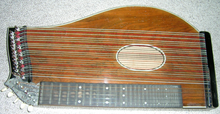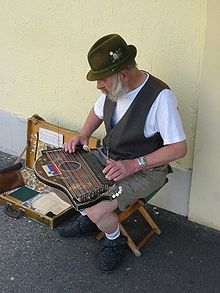Zither: Difference between revisions
| Line 38: | Line 38: | ||
*[http://www.zitherist.com "Zitherist International" Zither web magazine] |
*[http://www.zitherist.com "Zitherist International" Zither web magazine] |
||
*[http://www.zither.us "Zither US"] |
*[http://www.zither.us "Zither US"] |
||
*[http://de.wikipedia.org/wiki/Zither "German Wikipedia article"] (Expanded Wikipedia article in German, on Zithers) |
|||
{{Zithers}} |
{{Zithers}} |
||
Revision as of 17:51, 4 May 2012


The zither is a musical string instrument, most commonly found in Slovenia, Austria, Hungary, northwestern Croatia, the southern regions of Germany, alpine Europe and East Asian cultures, including China. The term "citre" is also used more broadly, to describe the entire family of stringed instruments in which the strings do not extend beyond the sounding box, including the hammered dulcimer, psaltery, Appalachian dulcimer, guqin, guzheng (Chinese zither), koto, gusli, kantele, gayageum, đàn tranh, kanun, autoharp, santoor, yangqin, piano, harpsichord, santur, swarmandal, and others. Modern electric zithers exist, as well as a wide variation of experimental zithers like the Kitaras of Harry Partch, the Shruti Stick and the Moodswinger. It is played by strumming or plucking the strings like a guitar.
Etymology and instrument family
The word "citara" is derived from the Greek word kithara, an instrument from classical times used in Ancient Greece and later throughout the Roman Empire and in the Arab world (Arabic قيثارة); the word "guitar" derives from "qithara" as well.
History and development

While the term zither is mentioned in Daniel during the Jewish exile of 606 BC, the earliest known instrument of the zither family is a Chinese guqin [a fretless instrument], found in the tomb of Marquis Yi of Zeng dating from 433 BC.[1] In modern entertainment, the zither is perhaps most famous for its role in the soundtrack, especially all along the classic noir film The Third Man. The music for the film was played by Anton Karas. It is also the preferred music of Mr. Bevis, a Twilight Zone character in 1960.
The instrument has a prominent solo in one of Johann Strauss II's most famous waltzes, "Tales from the Vienna Woods" (sometimes played on a mandolin, when a zither is not available). It is also used by multi-instrumentalist Laraaji on the third release of Brian Eno's ambient music series, Ambient 3: Day of Radiance. Australian-born singer Shirley Abicair popularised the zither when she used it widely as accompaniment in her TV shows, live performances and recordings in Britain in the 1950s and 1960s. More recently, Jerusalem-based multi-instrumentalist Bradley Fish has used zithers in a multitude of styles on the soundtracks of various Sony Digital Pictures films. In Slovenia, at the end of the 19th century they were used in small towns or villages and for concerts.
Like many other stringed instruments, acoustic and electric forms exist; in the acoustic version, the strings are stretched across the length of the soundbox, and neither version has a neck. They can be divided into two classes: fretted and fretless. A person who plays the zither is called a zitherist.
Playing

The zither is played by plucking the strings while it lies flat on a table, which acts as a resonator to amplify the sound.
The right thumb, wearing a thumb-mounted plectrum, picks out the melody on the five fretboard strings, which are stopped by the left hand like a guitar. Meanwhile, the remaining fingers of the right hand play accompanying chords on the open strings. Typically, these are grouped as follows: the first twelve strings after the fretboard are accompanying strings, then the next twelve are bass strings. All these are tuned according to the circle of fifths. After that, there may be some contrabass strings tuned chromatically. As few as two or three, or as many as thirteen, depending on the type of zither.
References
- ^ Stephen Jones. "Source and stream: early music and living traditions in China" (PDF). Oxford Journals.
{{cite journal}}: Cite journal requires|journal=(help); Italic or bold markup not allowed in:|publisher=(help)
Bibliography
- "Zither" from the University of Michigan School of Information's CHICO project
External links
select an article title from: Wikisource:1911 Encyclopædia Britannica
- "Fretless Zithers" at MinerMusic.com (history, family tree and photos)
- FretlessZithers.com
- Zither concert video: Hungarian violin virtuoso Félix Lajkó play a zither, with singer Magdolna Rúzsa accompanying, in a folk song interpretation.
- "Zither collection of the University of Leipzig"
- "Zitherist International" Zither web magazine
- "Zither US"
- "German Wikipedia article" (Expanded Wikipedia article in German, on Zithers)
